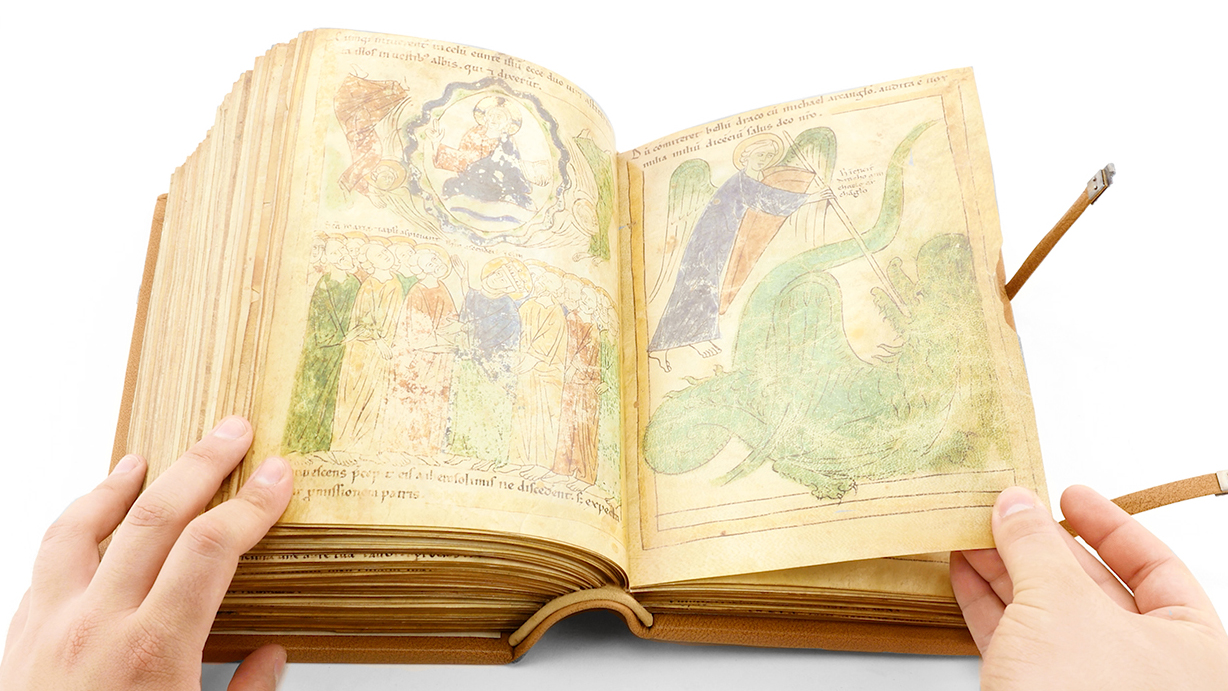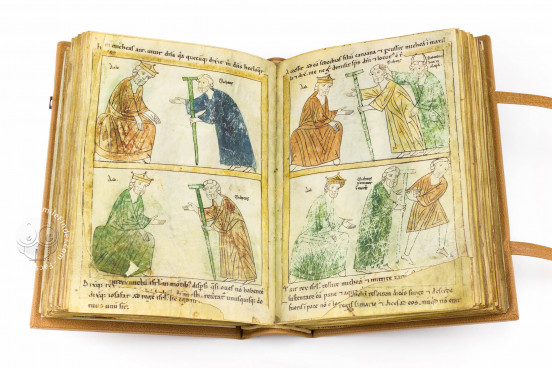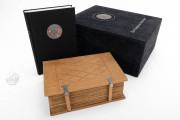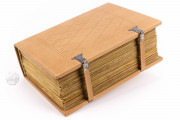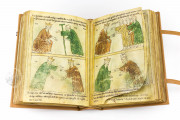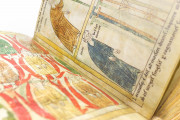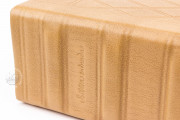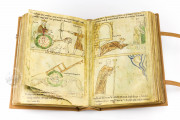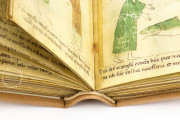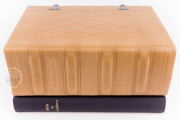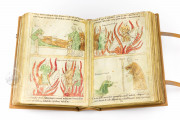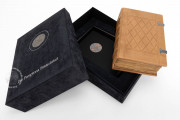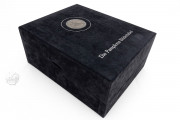The Pamplona Bible is an extraordinary example of the evolving characteristics of the Christian Bible. Also known as Pamplona Bible II, Augsburg Pamplona Bible, and the Harburg Pamplona Bible, it was completed around 1200. The Bible comprises three volumes with a large number of colored drawings in the Romanesque style. The drawings use simple and confident outlines and are both bold and evocative. The images are accompanied on the folio by explanatory notes, or captions, an unusual feature of the period, which together with the large number of depictions presages the later genre of Picture Bibles.
The Bible was made in Pamplona in the Kingdom of Navarre, Spain, with King Sancho VII (known as Sancho el Fuerte, the Strong) as patron. At the time, Spain was somewhat isolated from cross-cultural transmission which may account for some of the unusual and innovative depictions. These include Goliath, riding a horse in full chain mail and holding a lance, approaching David (fol. 100v). It is also important to note that it is one of two almost identical Bibles created within six months of each other.
Pamplona Bible II, as the name suggests, is the second of the two, and while the two are very similar, there are also differences. For example, Pamplona II has more Old Testament depictions (684, compared with 635), but fewer New Testament (102 compared with 105) than its earlier counterpart, which is now housed at Amiens, Bib. Mun. Ms Lat 108. The selection of texts between the two varies slightly, but at least 90% of the Bible texts are the same.
A Large Number of Large Drawings
The Pamplona II manuscript represents the largest extant Bible picture cycle before 1200, with a total of 976 colored lines and wash drawings of both the Old and New Testaments. The sources and models employed by the artists have been of great interest to scholars, especially since there is no earlier pictorial tradition in Navarre.
The drawings cover the large pages. Some pages have two depictions, one above the other, while others have a single depiction over the whole page. The drawings are the result of at least four artists identified as Masters A–D, who may also have worked on the earlier Amiens Pamplona Bible.
Colors employed include yellow, brown, green, blue, red (for fire, and blood), silver, and gold (for divine attributes.)
Text and Captions
The writing throughout the Bible is in Gothic minuscule. One scribe was responsible for the text while other scribes wrote captions. Gothic minuscule is related to the earlier Carolingian minuscule, and was in use from the early twelfth century until the seventeenth.
From Pamplona to Augsburg
The difference in the number of images between Pamplona Bible II and the earlier Amiens Bible is due in part to missing folios. The Amiens Pamplona Bible, for example, is missing the entire Genesis cycle.
There are deliberate alterations, however, to both text and image which may have been made to suit the recipient. There are indications that Pamplona Bible II may have been created for a woman, and possibly someone close to the king such as either his second wife, his sister Dona Teresa, Infanta of Navarre, or Sancha, the widow of King Alphons II of Aragon.
A colophon in Latin states that the project was completed under the guidance of Ferrandus Petri of Lunes: “Here ends the book, thank God, which the most illustrious King Sancho of Navarra, son of Sancho… had ordered made by Petrus Ferrandus from Funes.”
Petrus Ferrandus appears in other contemporary charters and by the time of the preparation of the Bible was both chancellor and archdeacon attached to the cathedral. He was responsible for the completion of the project and may well have had some involvement in the choice of depictions.
Notes on the Bible (fol. 12r) indicate that it was used in 1556 by the Spaniard Duarte Naberade. Between 1736 and 1819 it was in the possession of Charles Philippe Campion de Tersan. Another note indicates it was in Valladolid in northern Spain in 1809 (fol. 1r).
In 1814, a Parisian art collector, Abbé Charles, negotiated the sale of the manuscript to Ludwig Fürst von Oettingen-Wallerstein. It subsequently became the property of the Fürstlich Oettingen-Wallersteinsche Bibliothek.
Binding description
Half of the light-brown sheepskin binding has been renovated with a buckskin cover and reinforced. The cover is decorated with horizontal and vertical blind rulings creating a border. There are the remains of two clasps, since removed, on the front and back covers. The end papers are made of paper. An inscription on the book spine made by the librarian Loeffelholz in the 19th century reads: Biblia mind, Saec. XII.
We have 1 facsimile edition of the manuscript "Pamplona Bible": Biblia de Pamplona facsimile edition, published by Eikon Editores, 2005
Request Info / Price
